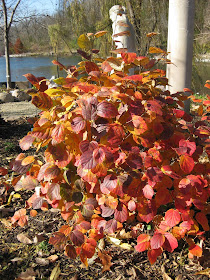Today, although breezy, was sunny and mild with a high temperature near 50 degrees F. The thaw continues outside but created a pool of water on top of remaining ice which has made for very slick conditions. Big John and Larry continued with various projects including the continuation of progress with taking down the Holiday Light Show (HLS). I continue with three months of desk work and planning that has to occur in the next six weeks. It's crunch time! We also saw Gary, Bob T., Vern, Bill O. and many others today. I have two presentations in Freeport, IL on Saturday for the Joys of Gardening Symposium hosted by the University of Illinois Extension and University of Illinois Master Gardeners.
This blog is a tribute to the witch alder (Fothergilla sp.) which I've always enjoyed. I should mention that we've had both successes and failures with this shrub which is native to the Eastern and Southeastern United States. Witch alders are in the Hamamelidaceae family along with witchhazels (Hamamelis). In essence, there are two native species...Fothergilla gardenii (dwarf fothergilla) and Fothergilla major (mountain fothergilla). However, there are some hybrid selections of crosses between both species which are considered Fothergilla x intermedia. Dwarf fothergillas will get around 3'-4' in our climate with the mountain fothergilla reaching 6'-8' ultimately. The hybrids vary in height but fothergillas are not noted for a fast growth rate so keep that in mind! The best article I've ever read on fothergillas is by Rick Darke and can be viewed at www.rickdarke.com/Fothergilla.pdf . What these slow growing shrubs have in common is beautiful, fragrant, early spring blossoms that look like little bottle brushes. The foliage catches up quickly after the blooms peak and the late fall color of these selections is excellent. There are some varieties with "blue" foliage that offer interesting foliage color although their fall color contribution is not as pronounced. Moist, acidic, organically rich soils with good drainage are essential although Fothergilla major is a bit more forgiving and is native to more upland areas. Many times witch alders are put in part shade under a deciduous canopy where they will grow although root competition from nearby trees may make for a less than ideal situation in terms of moisture. More flowers and better fall coloration will be seen in sunnier locations. The best specimens I've observed are in full sun. The variety above (and two photos below) is Fothergilla gardenii 'Julia' which is a solid performer as are the other varieties seen below. The blue forms have struggled for us but our greatest successes are with 'Mt. Airy' and Beaver Creek ('KLMtwo'). I only included the variety below but research a bit further in to the species and expected features (height, etc.) as you desire.
'Julia'
'Julia'
'Windy City'
'Windy City'
'Windy City' fall color (above and below)
'Blue Shadow'
'Blue Shadow'
'Blue Shadow'
'Blue Shadow'
'Blue Shadow' in bloom (above)
'Blue Mist'
'Jane Platt'
Beaver Creek ('KLMtwo')
Beaver Creek ('KLMtwo')
Beaver Creek ('KLMtwo')
Beaver Creek ('KLMtwo') fall color (above and two below)
Fothergilla major (above and all below)




























No comments:
Post a Comment